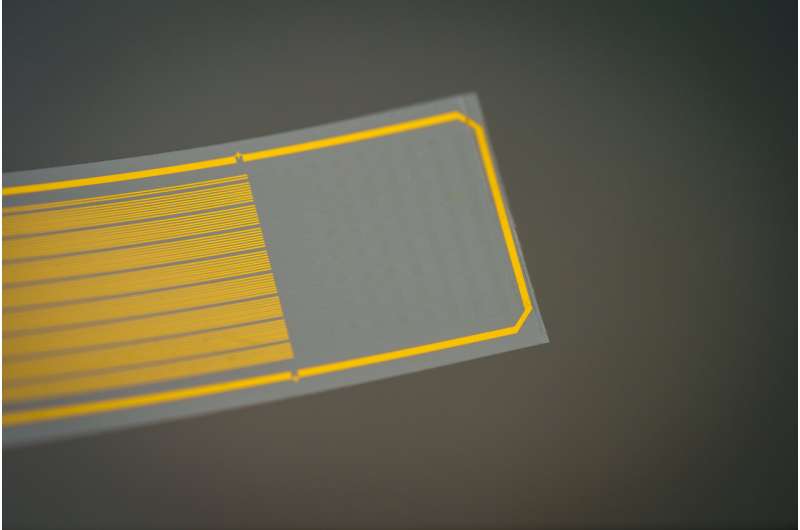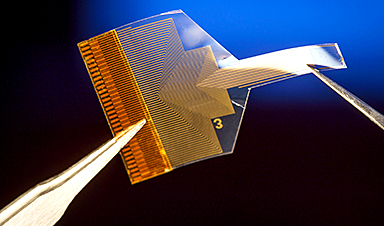Researchers at the University of California San Diego have developed a neural implant that provides information about activity deep inside the brain while sitting on its surface. The implant is made up of a thin, transparent and flexible polymer strip that is packed with a dense array of graphene electrodes. The technology, tested in transgenic mice, brings the researchers a step closer to building a minimally invasive brain-computer interface (BCI) that provides high-resolution data about deep neural activity by using recordings from the brain surface.
“We are expanding the spatial reach of neural recordings with this technology,” said study senior author Duygu Kuzum, a professor in the Department of Electrical and Computer Engineering at the UC San Diego Jacobs School of Engineering. “Even though our implant resides on the brain’s surface, its design goes beyond the limits of physical sensing in that it can infer neural activity from deeper layers.”
This work overcomes the limitations of current neural implant technologies. Existing surface arrays, for example, are minimally invasive, but they lack the ability to capture information beyond the brain’s outer layers. In contrast, electrode arrays with thin needles that penetrate the brain are capable of probing deeper layers, but they often lead to inflammation and scarring, compromising signal quality over time.
The new neural implant developed at UC San Diego offers the best of both worlds.
The implant is a thin, transparent and flexible polymer strip that conforms to the brain’s surface. The strip is embedded with a high-density array of tiny, circular graphene electrodes, each measuring 20 micrometers in diameter. Each electrode is connected by a micrometers-thin graphene wire to a circuit board.
In tests on transgenic mice, the implant enabled the researchers to capture high-resolution information about two types of neural activity—electrical activity and calcium activity—at the same time. When placed on the surface of the brain, the implant recorded electrical signals from neurons in the outer layers. At the same time, the researchers used a two-photon microscope to shine laser light through the implant to image calcium spikes from neurons located as deep as 250 micrometers below the surface.
The researchers found a correlation between surface electrical signals and calcium spikes in deeper layers. This correlation enabled the researchers to use surface electrical signals to train neural networks to predict calcium activity—not only for large populations of neurons, but also individual neurons—at various depths.
“The neural network model is trained to learn the relationship between the surface electrical recordings and the calcium ion activity of the neurons at depth,” said Kuzum. “Once it learns that relationship, we can use the model to predict the depth activity from the surface.”
An advantage of being able to predict calcium activity from electrical signals is that it overcomes the limitations of imaging experiments. When imaging calcium spikes, the subject’s head must be fixed under a microscope. Also, these experiments can only last for an hour or two at a time.
“Since electrical recordings do not have these limitations, our technology makes it possible to conduct longer duration experiments in which the subject is free to move around and perform complex behavioral tasks,” said study co-first author Mehrdad Ramezani, an electrical and computer engineering Ph.D. student in Kuzum’s lab. “This can provide a more comprehensive understanding of neural activity in dynamic, real-world scenarios.”
Designing and fabricating the neural implant
The technology owes its success to several innovative design features: transparency and high electrode density combined with machine learning methods.
“This new generation of transparent graphene electrodes embedded at high density enables us to sample neural activity with higher spatial resolution,” said Kuzum. “As a result, the quality of signals improves significantly. What makes this technology even more remarkable is the integration of machine learning methods, which make it possible to predict deep neural activity from surface signals.”

This study was a collaborative effort among multiple research groups at UC San Diego. The team, led by Kuzum, who specializes in developing multimodal neural interfaces, includes nanoengineering professor Ertugrul Cubukcu, who specializes in advanced micro- and nanofabrication techniques for graphene materials; electrical and computer engineering professor Vikash Gilja, whose lab integrates domain-specific knowledge from the fields of basic neuroscience, signal processing, and machine learning to decode neural signals; and neurobiology and neurosciences professor Takaki Komiyama, whose lab focuses on investigating neural circuit mechanisms that underlie flexible behaviors.
Transparency is one of the key features of this neural implant. Traditional implants use opaque metal materials for their electrodes and wires, which block the view of neurons beneath the electrodes during imaging experiments. In contrast, an implant made using graphene is transparent, which provides a completely clear field of view for a microscope during imaging experiments.
“Seamless integration of recording electrical signals and optical imaging of the neural activity at the same time is only possible with this technology,” said Kuzum. “Being able to conduct both experiments at the same time gives us more relevant data because we can see how the imaging experiments are time-coupled to the electrical recordings.”
To make the implant completely transparent, the researchers used super thin, long graphene wires instead of traditional metal wires to connect the electrodes to the circuit board. However, fabricating a single layer of graphene as a thin, long wire is challenging because any defect will render the wire nonfunctional, explained Ramezani. “There may be a gap in the graphene wire that prevents the electrical signal from flowing through, so you basically end up with a broken wire.”
The researchers addressed this issue using a clever technique. Instead of fabricating the wires as a single layer of graphene, they fabricated them as a double layer doped with nitric acid in the middle.
“By having two layers of graphene on top of one another, there’s a good chance that defects in one layer will be masked by the other layer, ensuring the creation of fully functional, thin and long graphene wires with improved conductivity,” said Ramezani.
According to the researchers, this study demonstrates the most densely packed transparent electrode array on a surface-sitting neural implant to date. Achieving high density required fabricating extremely small graphene electrodes. This presented a considerable challenge, as shrinking graphene electrodes in size increases their impedance—this hinders the flow of electrical current needed for recording neural activity.
To overcome this obstacle, the researchers used a microfabrication technique developed by Kuzum’s lab that involves depositing platinum nanoparticles onto the graphene electrodes. This approach significantly improved electron flow through the electrodes while keeping them tiny and transparent.
Next steps
The team will next focus on testing the technology in different animal models, with the ultimate goal of human translation in the future.
Kuzum’s research group is also dedicated to using the technology to advance fundamental neuroscience research. In that spirit, they are sharing the technology with labs across the U.S. and Europe, contributing to diverse studies ranging from understanding how vascular activity is coupled to electrical activity in the brain to investigating how place cells in the brain are so efficient at creating spatial memory.
“This technology can be used for so many different fundamental neuroscience investigations, and we are eager to do our part to accelerate progress in better understanding the human brain,” said Kuzum.
More information: High-density Transparent Graphene Arrays for Predicting Cellular Calcium Activity at Depth from Surface Potential Recordings, Nature Nanotechnology (2024). DOI: 10.1038/s41565-023-01576-z
Journal information: Nature Nanotechnology
News
Fever-Proof Bird Flu Variant Could Fuel the Next Pandemic
Bird flu viruses present a significant risk to humans because they can continue replicating at temperatures higher than a typical fever. Fever is one of the body’s main tools for slowing or stopping viral [...]
What could the future of nanoscience look like?
Society has a lot to thank for nanoscience. From improved health monitoring to reducing the size of electronics, scientists’ ability to delve deeper and better understand chemistry at the nanoscale has opened up numerous [...]
Scientists Melt Cancer’s Hidden “Power Hubs” and Stop Tumor Growth
Researchers discovered that in a rare kidney cancer, RNA builds droplet-like hubs that act as growth control centers inside tumor cells. By engineering a molecular switch to dissolve these hubs, they were able to halt cancer [...]
Platelet-inspired nanoparticles could improve treatment of inflammatory diseases
Scientists have developed platelet-inspired nanoparticles that deliver anti-inflammatory drugs directly to brain-computer interface implants, doubling their effectiveness. Scientists have found a way to improve the performance of brain-computer interface (BCI) electrodes by delivering anti-inflammatory drugs directly [...]
After 150 years, a new chapter in cancer therapy is finally beginning
For decades, researchers have been looking for ways to destroy cancer cells in a targeted manner without further weakening the body. But for many patients whose immune system is severely impaired by chemotherapy or radiation, [...]
Older chemical libraries show promise for fighting resistant strains of COVID-19 virus
SARS‑CoV‑2, the virus that causes COVID-19, continues to mutate, with some newer strains becoming less responsive to current antiviral treatments like Paxlovid. Now, University of California San Diego scientists and an international team of [...]
Lower doses of immunotherapy for skin cancer give better results, study suggests
According to a new study, lower doses of approved immunotherapy for malignant melanoma can give better results against tumors, while reducing side effects. This is reported by researchers at Karolinska Institutet in the Journal of the National [...]
Researchers highlight five pathways through which microplastics can harm the brain
Microplastics could be fueling neurodegenerative diseases like Alzheimer's and Parkinson's, with a new study highlighting five ways microplastics can trigger inflammation and damage in the brain. More than 57 million people live with dementia, [...]
Tiny Metal Nanodots Obliterate Cancer Cells While Largely Sparing Healthy Tissue
Scientists have developed tiny metal-oxide particles that push cancer cells past their stress limits while sparing healthy tissue. An international team led by RMIT University has developed tiny particles called nanodots, crafted from a metallic compound, [...]
Gold Nanoclusters Could Supercharge Quantum Computers
Researchers found that gold “super atoms” can behave like the atoms in top-tier quantum systems—only far easier to scale. These tiny clusters can be customized at the molecular level, offering a powerful, tunable foundation [...]
A single shot of HPV vaccine may be enough to fight cervical cancer, study finds
WASHINGTON -- A single HPV vaccination appears just as effective as two doses at preventing the viral infection that causes cervical cancer, researchers reported Wednesday. HPV, or human papillomavirus, is very common and spread [...]
New technique overcomes technological barrier in 3D brain imaging
Scientists at the Swiss Light Source SLS have succeeded in mapping a piece of brain tissue in 3D at unprecedented resolution using X-rays, non-destructively. The breakthrough overcomes a long-standing technological barrier that had limited [...]
Scientists Uncover Hidden Blood Pattern in Long COVID
Researchers found persistent microclot and NET structures in Long COVID blood that may explain long-lasting symptoms. Researchers examining Long COVID have identified a structural connection between circulating microclots and neutrophil extracellular traps (NETs). The [...]
This Cellular Trick Helps Cancer Spread, but Could Also Stop It
Groups of normal cbiells can sense far into their surroundings, helping explain cancer cell migration. Understanding this ability could lead to new ways to limit tumor spread. The tale of the princess and the [...]
New mRNA therapy targets drug-resistant pneumonia
Bacteria that multiply on surfaces are a major headache in health care when they gain a foothold on, for example, implants or in catheters. Researchers at Chalmers University of Technology in Sweden have found [...]
Current Heart Health Guidelines Are Failing To Catch a Deadly Genetic Killer
New research reveals that standard screening misses most people with a common inherited cholesterol disorder. A Mayo Clinic study reports that current genetic screening guidelines overlook most people who have familial hypercholesterolemia, an inherited disorder that [...]





















